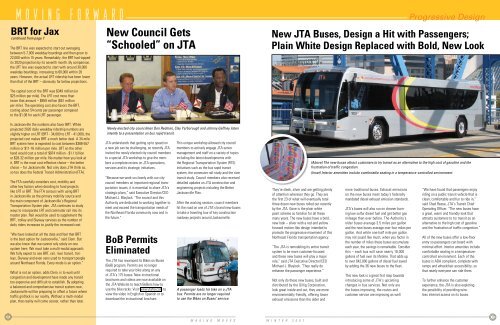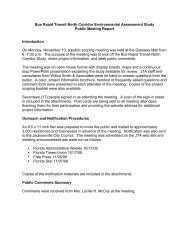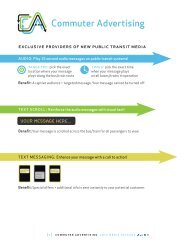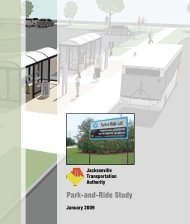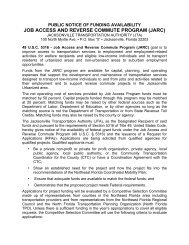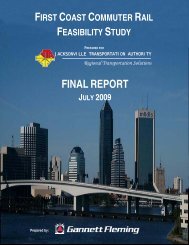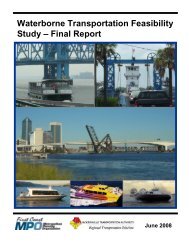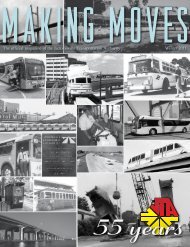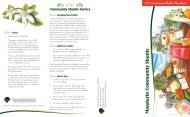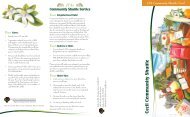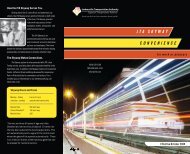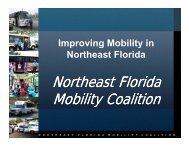jta classic - Jacksonville Transportation Authority
jta classic - Jacksonville Transportation Authority
jta classic - Jacksonville Transportation Authority
You also want an ePaper? Increase the reach of your titles
YUMPU automatically turns print PDFs into web optimized ePapers that Google loves.
M O V I N G F O R W A R D<br />
BRT for Jax<br />
continued from page 7<br />
The BRT line was expected to start out averaging<br />
between 5-7,000 weekday boardings and then grow to<br />
22,000 within 15 years. Remarkably, the BRT had topped<br />
its 2020 projection by its seventh month. By comparison,<br />
the LRT line was expected to start with around 30,000<br />
weekday boardings, increasing to 60,000 within 20<br />
years. However, the actual LRT ridership has been lower<br />
than that of the BRT – obviously far below projections.<br />
New Council Gets<br />
“Schooled” on JTA<br />
Progressive Design<br />
New JTA Buses, Design a Hit with Passengers;<br />
Plain White Design Replaced with Bold, New Look<br />
The capital cost of the BRT was $349 million (or<br />
$25 million per mile). The LRT cost more than<br />
twice that amount – $859 million ($61 million<br />
per mile). The operating cost also favors the BRT,<br />
costing about 54 cents per passenger compared<br />
to the $1.08 for each LRT passenger.<br />
In <strong>Jacksonville</strong> the numbers also favor BRT. While<br />
projected 2020 daily weekday ridership numbers are<br />
slightly higher on LRT (BRT - 34,000 to LRT - 41,000), the<br />
projected cost makes BRT a much better deal. A 34-mile<br />
BRT system here is expected to cost between $388-557<br />
million or $11-16 million per mile. LRT on the other<br />
hand would cost a total of $974 million - $1.1 billion<br />
or $28-32 million per mile. No matter how you look at<br />
it, BRT is the most cost-effective choice – the better<br />
choice – for <strong>Jacksonville</strong>. Not only does JTA think so,<br />
so too does the Federal Transit Administration (FTA).<br />
The FTA carefully considers cost, mobility and<br />
other key factors when deciding to fund projects<br />
like LRT or BRT. The FTA concurs with using BRT<br />
in <strong>Jacksonville</strong> as the primary mobility source and<br />
the main component of <strong>Jacksonville</strong>’s Regional<br />
<strong>Transportation</strong> System plan. JTA continues to study<br />
ways to incorporate LRT and commuter rail into its<br />
master plan. Rail would be used to supplement the<br />
BRT, trolley and Skyway services as the number of<br />
daily riders increases to justify the increased cost.<br />
“We have looked at all the data and feel that BRT<br />
is the best option for <strong>Jacksonville</strong>,” said Clem. But<br />
we also know that we cannot rely solely on one<br />
system here. We must take a multi-modal approach.<br />
We fully expect to see BRT, rail, river transit, trolleys,<br />
Skyway and even vans used to transport people<br />
around Northeast Florida. Every mode is an option.”<br />
What is not an option, adds Clem, is to wait until<br />
congestion and development have made any transit<br />
too expensive and difficult to establish. By adopting<br />
a balanced and comprehensive transit system now,<br />
<strong>Jacksonville</strong> will be preparing to offset a future where<br />
traffic gridlock is our reality. Without a multi-modal<br />
plan, that reality will come sooner, rather than later.<br />
Newly elected city councilmen Don Redman, Clay Yarborough and Johnny Gaffney listen<br />
intently to a presentation on bus rapid transit.<br />
JTA understands that getting up to speed on<br />
a new job can be challenging, so recently JTA<br />
invited the newly elected city council members<br />
to a special JTA workshop to give the members<br />
a complete review on JTA operations,<br />
services and its strategic initiatives.<br />
“Because we work so closely with our city<br />
council members on important regional transportation<br />
issues, it is essential to share JTA’s<br />
strategic plans,” said Executive Director/CEO<br />
Michael J. Blaylock. “The council and this<br />
<strong>Authority</strong> are dedicated to working together to<br />
meet and exceed the transportation needs of<br />
the Northeast Florida community now and in<br />
the future.”<br />
BoB Permits<br />
Eliminated<br />
The JTA has revamped its Bikes on Buses<br />
(BoB) program. Permits are no longer<br />
required to take your bike along on any<br />
of JTA’s 175 buses. New instructional<br />
brochures and videos are now available on<br />
the JTA Website to teach BoBers how to<br />
use the bike racks. Visit www.<strong>jta</strong>fla.com to<br />
view the video in English or Spanish or to<br />
download the instructional brochure.<br />
This unique workshop allowed city council<br />
members to actively engage JTA senior<br />
management and staff on a variety of topics<br />
including the latest developments with<br />
the Regional <strong>Transportation</strong> System (RTS)<br />
initiatives such as the bus rapid transit<br />
system, the commuter rail study and the river<br />
transit study. Council members also received<br />
detailed updates on JTA construction and<br />
engineering projects including the Better<br />
<strong>Jacksonville</strong> Plan.<br />
After the working session, council members<br />
hit the road on one of JTA’s brand new buses<br />
to take a traveling tour of key construction<br />
roadway projects around <strong>Jacksonville</strong>.<br />
A passenger loads his bike on a JTA<br />
bus. Permits are no longer required<br />
to use the Bikes on Buses’ service.<br />
They’re sleek, silver and are getting plenty<br />
of attention wherever they go. They are<br />
the first 23 of what will eventually total<br />
three dozen new buses rolled out recently<br />
by the JTA. Gone is the plain white<br />
paint scheme so familiar for all these<br />
many years. The new buses have a bold,<br />
new look – silver with a red and yellow<br />
forward motion-like design intended to<br />
promote the progressive movement of this<br />
Northeast Florida transportation agency.<br />
“The JTA is remodeling its entire transit<br />
system to be more customer-focused<br />
and these new buses will play a major<br />
role,” said JTA Executive Director/CEO<br />
Michael J. Blaylock. “They really do<br />
enhance the passenger experience.”<br />
Not only do these new buses, built and<br />
distributed by the Gillig Corporation,<br />
look great inside and out, they are more<br />
environmentally friendly, offering lower<br />
exhaust emissions than the older and<br />
(Above) The new buses attract customers to try transit as an alternative to the high cost of gasoline and the<br />
frustration of traffic congestion.<br />
(Inset) Interior amenities include comfortable seating in a temperature-controlled environment.<br />
more traditional buses. Exhaust emissions<br />
on the new buses meet today’s federally<br />
mandated diesel exhaust emission standards.<br />
JTA’s buses will also run on cleaner burning<br />
low sulfur diesel fuel and get better gas<br />
mileage than ever before. The <strong>Authority</strong>’s<br />
older buses average 3.5 miles per gallon<br />
and the new buses average over four miles per<br />
gallon. And while one-half mile per gallon<br />
may not sound like much, when you factor in<br />
the number of miles these buses accumulate<br />
each year, the savings is remarkable. Consider<br />
this – each bus will save nearly 18,000<br />
gallons of fuel over its lifetime. That adds up<br />
to over 642,000 gallons of diesel fuel saved<br />
by adding the 36 new buses to the fleet.<br />
This new look is a great first step towards<br />
introducing some of JTA’s upcoming<br />
changes in bus services. Not only are<br />
the buses improving, the routes and<br />
customer service are improving as well.<br />
“We have found that passengers enjoy<br />
riding on a public transit vehicle that is<br />
clean, comfortable and fun to ride in,”<br />
said Chad Reese, JTA’s Transit Chief<br />
Operating Officer. “The new buses have<br />
a great, warm and friendly look that<br />
attracts customers to try transit as an<br />
alternative to the high cost of gasoline<br />
and the frustration of traffic congestion.”<br />
All of the new buses offer a low-floor<br />
entry so passengers can board with<br />
minimal effort. Interior amenities include<br />
comfortable seating in a temperaturecontrolled<br />
environment. Each of the<br />
buses is ADA compliant, complete with<br />
ramps and wheelchair accessibility, so<br />
that nearly everyone can ride them.<br />
To further enhance the customer<br />
experience, the JTA is also exploring<br />
the possibility of providing wireless<br />
internet access on its buses.<br />
12<br />
M A K I N G M O V E S<br />
W I N T E R 2 0 0 7<br />
13


